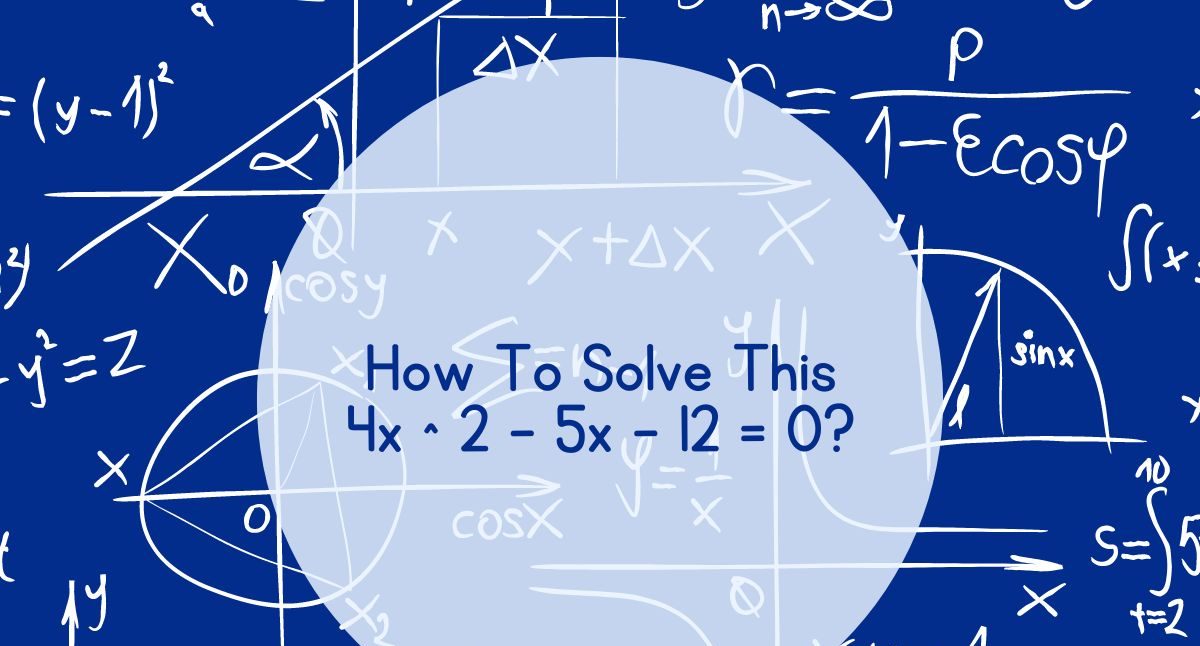Quadratic equations are a fundamental part of algebra, and they appear in various aspects of mathematics and science. In this comprehensive article, we will delve deeply into the quadratic equation 4x ^ 2 – 5x – 12 = 0, exploring its solutions and providing valuable insights on how to tackle similar equations.
Understanding Quadratic Equations 4x ^ 2 – 5x – 12 = 0
Quadratic equations are polynomial equations of the second degree, and they have a standardized form: ax^2 + bx + c = 0. Here, ‘a,’ ‘b,’ and ‘c’ are constants, and ‘x’ represents the variable. The equation we’ll be focusing on, 4x ^ 2 – 5x – 12 = 0, is indeed a quadratic equation.
Quadratic equations are ubiquitous in mathematics and science because they model various real-world phenomena, from the motion of projectiles to the growth of populations. Hence, having a profound understanding of how to solve them is crucial for mastering these fields.
The Importance of Quadratic Equations 4x ^ 2 – 5x – 12 = 0
Quadratic equations find applications in diverse disciplines, making them indispensable in the world of mathematics and beyond. Let’s explore why they are so important:
- Physics: In physics, quadratic equations are used to describe the motion of objects under the influence of gravity. For instance, when calculating the trajectory of a launched projectile, we often encounter quadratic equations.
- Engineering: Engineers employ quadratic equations when designing structures, analyzing electrical circuits, and predicting mechanical behaviors. They provide essential tools for optimizing designs and ensuring the safety and functionality of various systems.
- Economics: In economics, quadratic equations are used to model revenue, cost, and profit functions. Businesses use them to determine the price points that maximize profits or minimize costs.
- Biology: Biologists use quadratic equations to study population dynamics, the growth of organisms, and the spread of diseases. These equations help researchers make predictions and formulate strategies for managing biological systems.
Solving 4x ^ 2 – 5x – 12 = 0
Factoring
One common method to solve quadratic equations is factoring, a technique that involves rewriting the equation in a way that makes it easier to find the values of ‘x’ that satisfy it. To factor the quadratic equation 4x ^ 2 – 5x – 12 = 0, we need to find two numbers whose product equals the product of the leading coefficient ‘a’ and the constant term ‘c’ (in this case, 4 * -12 = -48) and whose sum equals the coefficient of ‘x’ (‘b,’ which is -5). These numbers are -8 and 6.
So, we can rewrite the equation as follows: (4x^2 – 8x) + (3x – 12) = 0.
Grouping and Factoring
To proceed, we group the terms with common factors and factor them separately: 4x(x – 2) + 3(x – 4) = 0.
Now, we can see that both terms share a common factor, which is (x – 2): (x – 2)(4x + 3) = 0.
Solving for ‘x’
With the equation factored, we can now find the solutions by setting each factor equal to zero:
- x – 2 = 0
- 4x + 3 = 0.
Solving these equations separately, we find the solutions:
- x = 2
- 4x = -3 x = -3/4.
Conclusion
In conclusion, understanding how to solve quadratic equations, such as 4x ^ 2 – 5x – 12 = 0, is a valuable skill with wide-ranging applications in mathematics, science, and real-life scenarios. We have explored the factoring method as a powerful tool to find the solutions to such equations, but other methods like the quadratic formula and completing the square can also be employed.
